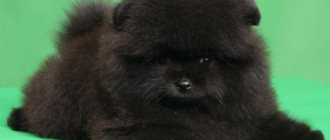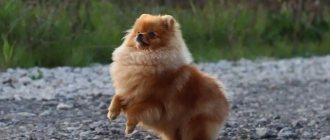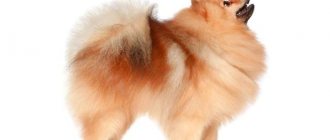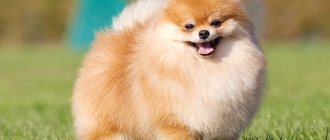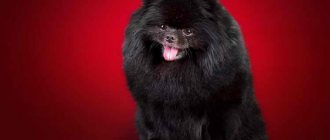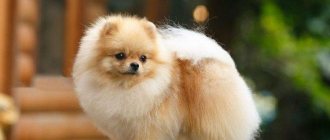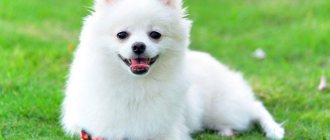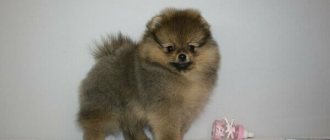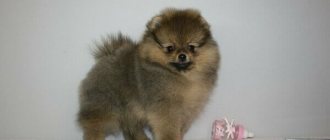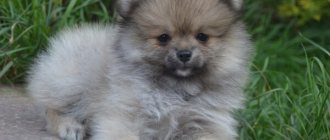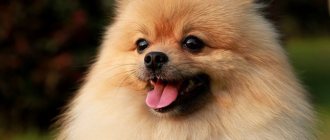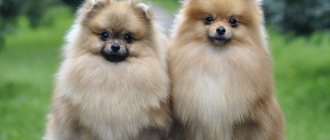German Spitz are adorable dogs that are ideal for people, those who love active recreation and attention from their pet. The breed was formed in Germany in the Middle Ages, when Spitz dogs were human assistants in protecting herds of domestic animals.
The size of the dogs did not matter; small representatives of the breed were not specifically crossed. Thanks to this, the color of the Spitz still has variety, which is assigned in the breed standard .
Dogs can be silver, chocolate, beige and, of course, red. In the 18th century, the rest of Europe became interested in the breed, and puppies began to be bred as indoor decorative dogs, which received the international name - Pomeranian Spitz. The size of such a dog does not exceed 22 cm, and the weight should be proportional to its height.
Today, the standard provides for 5 types of Spitz, varying in height at the withers and color. The Pomeranian, otherwise called the dwarf, is also included in the standard; its color can be red, cream, zoned, spotted black or spotted.
Thoughtful selection led to the emergence of subtypes among oranges. These are dogs of the so-called fox and bear types.
The fashion for the breed does not change, and Spitz dogs are very popular dogs, especially for urban residents, but the choice of the popular shape of the face and ears of the future pet involves varying prices for these types.
Important! Remember that only a fox-like muzzle and triangular ears are considered standard for miniature Spitz dogs - you can participate in exhibitions with such a dog. A bear puppy will not be allowed to participate in competitions.
The Little Fox Spitz and the Bear Spitz are the same breed, the only difference being the shape of the head and ears. It is important to note that the appearance of a puppy of one or another subtype is determined by genetics.
Parents who have all the classic traits of the breed can produce puppies of both the bear and fox type . This means that one of the dogs of previous generations had round ears and a short muzzle.
Breeding exclusively the bear type is impossible, and even if such dogs are obtained with a very short muzzle, more reminiscent of the flattened profile of a Pekingese, then they are not distinguished by good health. Respiratory diseases shorten the lifespan of these dogs, so such breeding is not encouraged by kennels that care about the quality of the breed standard.
Brief history of origin
The Fox Spitz is not an independent breed - it is a conditional subspecies of the Pomeranian Spitz. The latter was bred in Great Britain, and its ancestor was the German Spitz, widely known in Europe.
Interesting Facts:
- When developing the breed, German breeders rejected dogs that were too small. But in England they took root and gave birth to Pomeranians.
- The scientist Newton, who discovered universal gravity, had a favorite dog - a Spitz.
- Many movie stars have representatives of this breed. Their fans include: Maria Sharapova, Mickey Rourke, Nicole Richie, Sharon Osbourne, Sylvester Stallone and others.
- During the sinking of the Titanic, three dogs were saved from the ship and two of them were Spitz dogs - they belonged to the Rothschilds.
Tendency to diseases
Spitz are dogs with good health. They are distinguished by their longevity. With good care they live up to 20 years. But even they can be plagued by diseases that you need to know about:
- diseases of the musculoskeletal system (necrosis of the femoral head, subluxation of joints, dislocation of the patella);
- complications during labor;
- bulging eyes characteristic of dwarf breeds;
- eye diseases (including cataracts, entropion, retinal dysplasia and atrophy);
- complications with teeth (especially during their change).
- inguinal and umbilical hernias;
- heart diseases;
- breathing problems, frequent coughing and sneezing.
Description and breed standard
When looking at the Pomeranian "fox" Spitz, the first thing that catches your eye is the small size of the dog - the height at the withers is about 18-22 cm. The weight corresponds to the size - the pet should not be too large and well-fed, so it is important to monitor feeding, because Spitz dogs should be fine-boned and graceful.
Advice! Spitz dogs should not be cut short - this can lead to baldness.
The maximum is to carefully trim the fur. The coat is thick, primarily due to the undercoat. At the same time, it sticks out in different directions, which makes the Spitz look like a ball of fluff.
Luxurious white spitz
But the color can be very different: black, red (shades from dark yellow to brown), white and others.
Differences
Chanterelles have differences from other types.
From bearish
Spitz bears and foxes are not at all similar. Among dwarf oranges, bear cubs are the most popular and are in high demand. Looking at their appearance, you can immediately notice their characteristic features.
- Bears have a disproportionately large head and a flat muzzle. Chanterelles have a small, wedge-shaped head with a cunning elongated nose that matches the proportions of the body.
- The bear's chin is always raised, so it seems that the baby is looking up. In chanterelles, due to their scissor bite, the chin is generally difficult to find.
- The bear's nose is higher than that of a fox's.
- The ears are small, round, as if buried in wool. They are noticeably different from the pointed, protruding ears of a fox cub.
- The bear's fur, unlike the fox's, is short, like that of a plush toy.
- The body of the robust creatures is wide, reminiscent of real bear cubs, which is strikingly different from the graceful body of the chanterelles.
The bear type is so popular with buyers that breeders often sell dogs that do not meet the accepted standard, which must be culled and neutered to prevent the misbreeding from continuing. Deviations from the standard affect the health and longevity of the pet.
For example, if an adult dog has a muzzle that is only 1 cm smaller than normal (4 instead of 5), the pet may have problems with breathing, and subsequently with the vascular system.
From a toy
The Japanese developed the toy Spitz. It is impossible to distinguish it from a soft toy until the dog begins to move. Until recently, this baby's color was exclusively white. Today they are trying to breed dogs with different shades, they already represent the population at exhibitions, but as before, the most expensive representatives of this group are white, their cost ranges from 25 to 40 thousand rubles. If you compare the toy orange with other types of oranges, it will turn out to be more similar to the bear type:
- the muzzle is like that of a bear cub, only even more flattened, the complete opposite of the elongated fox;
- the eyes are further apart from each other than in other types;
- strong, but not as clumsy as bear cubs, and not as graceful as fox cubs;
- the toy appearance is given by unnaturally thick, pleasant-to-touch fur;
- A distinctive feature of the toy type is its incredibly fluffy tail.
What is the difference between a Spitz bear and a fox
Another popular subspecies of the breed is the bear. The most reliable way to distinguish a “bear” from a “fox” is to compare their ears. For the former, they fully comply with the standard, that is, they have a triangular shape. But the second ones have rounded ones. Moreover, the difference appears quite early - at about 3-4 months. Therefore, the risk of error is quite small. And in adults it is even more noticeable. In addition, the latter really look like bear cubs - they are not so tall, more squat.
The bear cub is immediately visible
Basic Physiology: Examination of the Genitals
So, the main and most, as they say, reliable method of determining the sex of a dog is examination of the genitals. However, everything would seem to be very simple, if not for one “but”: in puppies, in the first days and weeks of life, sexual characteristics are poorly formed, which complicates the situation. Of course, the first thing a dog owner needs to know and understand is the physiology of the animal. Let's look at this in more detail.
Gender characteristics of a male dog:
- in male dogs up to 8 weeks of life, the genitals are poorly formed, the testicles are not yet visible, but the gender can be recognized by the tiny penis present;
- In the area just below the belly button, where there is virtually no hair, the newborn puppy will have a small fold of skin and a small protrusion. If the dog has long hair, then there may be a clearly visible tuft of hair;
- Under the tail, the male will have only one anus and between the paws there will also be a small tuft of hair. This is where the testicles will be located in the future.
Sexual characteristics of the bitch:
- In female dogs there will be no tuft of hair or palpable protrusion in the navel area. But there may be small nipple nipples (they also happen in males);
- Under the tail of girls, just below the anus, almost in the area between the paws, there will be a small seal-button. This is the genital slit. You can see more details in the photo.
Sexual characteristics of a bitch
Gender characteristics of a male dog
Expert advice
If you want to find out the gender of the puppy, it is important to carry out the examination very carefully, as babies are very sensitive and fragile. Don’t rush to examine and pick up your newborn baby right away.
Firstly, in the first days and even weeks it is very difficult to understand anything, and secondly, this can weaken the smell of the puppy for the bitch. It is best to carry out gender determination manipulations after 3-4 weeks of life.
Observe whether the male dog's scrotum is developing and whether the penis is becoming more pronounced. Also, male puppies are slightly larger than girls. To conduct a proper examination of the puppy, take a soft terry towel pre-heated on the radiator. Spread the towel on a flat surface, make a small indentation with your hands and place it gently on the puppy's back, holding it with your hand. Try to pet and relax the puppy. In this position, lying on his back, the baby will keep his legs bent, so it will be convenient to examine his stomach and groin. All actions must be very careful, calm and careful.
Pros and cons of the breed
Before getting a dwarf Spitz, it is better to understand the intricacies of their character and the rules of training. Otherwise, in the future you may greatly regret the unsuccessful purchase.
Features of character and behavior
The Spitz type "fox" has a surprisingly positive character. He loves to run, jump and share his irrepressible energy with everyone around him. He gets along well with children, making him an excellent choice for family keeping.
But there are some drawbacks here too. Despite its small size, the Spitz constantly perceives surrounding dogs (especially large ones) as potential competitors. And all the time he tries to prove to them that he is not afraid of them and is not going to give in. So, the risk of conflicts is quite high - you need to carefully monitor your pet during walks.
Training and education
Training a Spitz is pure pleasure. The dog instantly grasps everything and happily follows commands, from the simplest to the most complex. True, he gets tired quite quickly - you shouldn’t force him to give a paw, bark, or bring a stick for a long time. It is better to do several approaches with short breaks.
Pet training
It is also worth considering that the Spitz is constantly trying to take the top place in the family hierarchy - he will definitely check the owner, and here he should not be given any slack. Otherwise, he will turn into a real domestic tyrant.
Who is better to take - a boy or a girl?
There are some nuances to choosing an animal by gender. If the dog is planned to be shown at exhibitions, then gender is of great importance.
Male Spitz dogs, when compared with bitches of this breed, look more advantageous. They are much stronger and larger. They have a thicker, longer, fuller and richer coat. Males can be affectionate, but they rarely show these feelings.
However, we must take into account that when raising them, problems arise due to:
- tough temperament;
- persistence;
- a lot of stubbornness.
Spitz boys are cocky and often initiate fights with other dogs, even large ones. They always try to protect their owner and their territory.
If during a walk a male dog smells a female dog who is in heat, he will definitely run after her, and as a result he may even get lost.
An adult male Spitz marks everything he can reach in the apartment, so you will have to go for a walk with him 2 times a day. He will also put tags when visiting.
Spitz girls are easier to educate and train, because their character is good-natured and easy-going. There are no problems with the toilet. They are much cleaner than boys.
However, it causes trouble:
- estrus;
- possible pregnancy;
- childbirth;
- puppies.
Estrus in Spitz bitches occurs 1-2 times a year and lasts 3 weeks. At this time, when walking with the dog, you need to keep it on a leash so that unwanted matings do not occur. During heat, the girl needs to wear panties to protect the furniture and things in the apartment from stains. Pregnancy and lactation of bitches cause troubles and worries.
If you want to have offspring from a girl Spitz, then it is best to choose a simple bitch that does not have a show appearance. You need to make sure that it is quite heavy and large. She should have a wide pelvis and balanced, folding movements. Spitz girls inherit maternal instincts.
Therefore, when purchasing, it is advisable to look at her mother and ask the breeder about her attitude towards her offspring, the viability of her puppies, their number in the litter (there should not be more than 4). Rumors that nulliparous bitches are more likely to get cancer are not true. Therefore, Spitz girls can live well without mating and puppies.
Health and life expectancy
It is very important to protect the puppy from serious overload for up to a year - thin bones and weak joints are easily damaged. Therefore, it is advisable that he does not jump from a great height.
An incorrect diet often leads not only to diseases affecting the gastrointestinal tract, but also to obesity - nutrition should be balanced and moderate.
On a note! Spitz, despite their lush fur, do not tolerate cold well - in winter the duration of walks should be reduced.
If the pet is provided with good care, then it will probably live 14-16 years. This is a very good indicator for dogs.
Owner reviews
Irina T.:
“The dog is 2.5 years old, she has been living with us for 2 years - she is a fairly independent girl. But I got used to her for about six months, tried to immediately put myself in charge of her, raised her like a big dog, without concessions. So she got used to it: she doesn’t spoil things, she doesn’t beg, she doesn’t pester her with games. But she loves me more than anyone in the family, even though I’m strict with her.”
Ekaterina A.:
“I got the dog when she was six months old. I think this is the optimal age to buy a puppy, because its advantages and disadvantages and health problems are already visible. Almost immediately I realized how much money is needed to provide normal care for even a young Pomeranian. A lot of. The story of puddles all over the house continued for a year. At first Timka was afraid, but then he got used to it and followed me everywhere. Many different toys saved the furniture from puppy teeth. His voice emerged very quickly and turned out to be loud and ringing. He himself is sensitive, affectionate, restless.”
Pet care
Like any dog, the white fox Spitz needs care. His appearance and health depend on this.
Diet
A good choice would be ready-made dry food - it contains all the necessary vitamins and microelements. The main thing is to buy quality food. It contains meat, not soy. It is not cheap, but the Spitz eats very little - 3-4 kg of food is enough for a month.
What to feed a Spitz fox
In addition, it is advisable to purchase special food for miniature dogs - large granules may be too much for a Spitz with its weak jaws.
Grooming
In order for wool to look chic, it needs to be properly cared for. She needs to be brushed twice a week, and when the Spitz sheds, the procedure needs to be done daily.
Note! It is best to use a plastic comb, and ideally a bone comb. Metal damages the fur.
Don't forget about the bath. You need to bathe your Spitz every two months using a special shampoo.
Walking and physical activity
It is advisable to walk in the morning and evening. Morning exercise is at least 10-15 minutes, and evening exercise is from half an hour. During the walk, the dog should run around a lot. True, long-term exercise is not suitable for him - let him run a little after the ball, and then rest, lying next to his beloved owner.
Walks are very important for your pet
In the summer heat, it is advisable to reduce your load and always have a bottle of water with you.
Fox type
The American Quesnel Club standard describes exactly this type of Pomeranian: with an elongated muzzle, very similar to a fox. In addition to their wedge-shaped muzzle, these dogs have fluffy cheeks, round eyes, a narrow chin and a small button-shaped nose.
These Spitz resemble a fox not only in the shape of the muzzle, head and ears, but also in almost their entire appearance. The tail of these Pomeranians is longer than that of the “bear” type of dog.
This type of Pomeranian can easily be confused with the classic German exterior. But there are still differences: longer legs and less long coat.
Fox-type Pomeranian puppies are the cheapest, as they are less in demand today. Breeders who follow fashion trends consider this type of Spitz to be a defect, but it is not fashion that dictates the conditions, but the standard. It is according to the standard that fox-type puppies are mainly purebred and, accordingly, the most promising for breeding and participation in exhibitions.
How to choose a puppy
The choice of puppy determines whether the breeder will face unnecessary problems in the future. You need to pay attention to factors such as:
- Presence of illnesses in parents. It is advisable to look at the veterinary passports.
- Appearance of a puppy. The coat should be smooth and even, and the dog should be moderately well-fed.
- Psychological condition. Cowardly or angry dogs will certainly cause a lot of additional difficulties for the owner.
Keeping these rules in mind, any breeder will choose a pet that will become a member of the family for many years.
Types of white Spitz
The white Spitz attracts the attention of many. After all, snow-white shiny wool looks rich
Such dogs were bred in several countries, and the following representatives of the breed with white hair are known in the world:
- Japanese Spitz. Came to Japan from Siberia and China, where it has been bred since the 20s of the last century. At the withers, the height reaches 40 cm; the color of the coat does not change with age. Has a black nose, dark eyes, black lip contour. The dog is distinguished as clean. Like all representatives of the breed, he needs to be brushed frequently (every day or 3 times a week).
- American Eskimo Spitz. It has a history similar to Japanese. White dogs came to America in the 20th century, where they became popular, and by 1970 a standard had been formed. This type has three varieties in height - from toy (23 - 30 cm) to large (38 - 42 cm). Playful and hyperactive, like all his brothers of other colors.
- Large German Spitz. An ordinary red or black dog by crossing white dogs has obtained a snow-white coat, which can fade into cream or reddish-beige. The pet's height reaches 50 cm. The standard corresponds to an animal with dark eyes and a black nose, without spots. The coat is thick and long.
- Volpino Italiano. In the 17th century, it began to be bred in Italy as a decorative dog for rich ladies. Reaches a height of 30 cm at the withers. There are black and red Volpino, but rarely, since white is considered the standard, and kennels breed dogs of this color.
- Small German Spitz and Pomeranian Spitz are sometimes born white and do not change color, but this is a rare case, and such puppies need to be “hunted” if you are determined to have a snow-white dog.
Price
In the cabin
Salon grooming is a whole range of procedures, not just a haircut. Includes:
- combing;
- bathing;
- drying;
- a haircut;
- cleaning ears, eyes;
- trimming nails.
The prices for the procedure are quite high. In a professional establishment they start from 2,000 rubles. (in Moscow).
Before and after grooming
At home
To save money, you can call a groomer to your home after brushing and bathing yourself. Then a haircut will cost from 1,000 rubles.
You can also perform a regular hygienic haircut yourself for free. It’s not worth the risk of styling it as a fox cub yourself, so as not to harm the dog.
